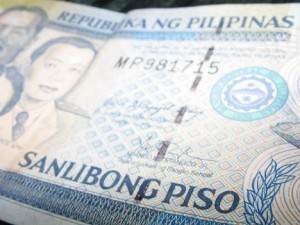MANILA, Philippines – The peso fell to the 42-to-a-dollar territory on Wednesday, registering its weakest close in nine months, as reports of an improving economy of the United States pushed demand for the greenback and led to the dumping of emerging-market currencies.

The local currency closed at its intraday low of 42.44 against the US dollar, down by 49 centavos from Tuesday’s finish of 41.95:$1. Intraday high stood at 42.10:$1.
Significant appetite for the dollar led to the increase in trade volume, which amounted to $1.06 billion compared with the $879.9 million the previous day.
The drop of the peso and other emerging-market currencies came amid concerns about potential flight of substantial capital away from developing countries given the recovery of the United States from its latest economic crisis.
The Bangko Sentral ng Pilipinas, however, was firm that the Philippines would not suffer from substantial capital flight given the country’s favorable macroeconomic fundamentals. It maintains the view that the Philippines, which enjoys rosy economic growth outlooks from various institutions, will continues to entice foreign portfolio investors.
The BSP said the peso’s depreciation on Wednesday was brought about by external factors and did not signal problems in the Philippine economy.
BSP Governor Amando Tetangco Jr. said the weakening of the peso was a result of the foreign-exchange market’s excitement over the dollar that came following the release of encouraging data for the world’s biggest economy.
In particular, reports said home prices in the United States grew year on year by 10.9 percent in March, the biggest gain in seven years. Also, the US consumer confidence index rose to 76.2 in May, the highest since the start of the US economy’s crisis in 2008.
“The peso’s weakness reflects in part the dollar’s strength overnight given good US economic data. As we know, markets tend to behave this way until fresh news comes out,” Tetangco told reporters.
He shrugged off concerns over exchange-rate volatility, saying the pace of the peso’s fall on Wednesday was more or less the same as the movement of other emerging-market currencies against the US dollar.
“The market today is just trying to take a breather, using the overnight dollar action as basis to create room to maneuver. This is still healthy and should not be a cause for concern,” Tetangco said.
Jonathan Ravelas, market strategist from Banco de Oro, said the market responded excitedly over developments in the United States. He said reports that the US Federal Reserve would eventually slow down in its bond purchase program was likewise taken by the market as indication of an improving US economy.
He said the peso could weaken further in the coming months to reach 43 to a dollar.
“The statement from the US Fed is a clear manifestation that the US economy is getting stronger,” Ravelas said.

